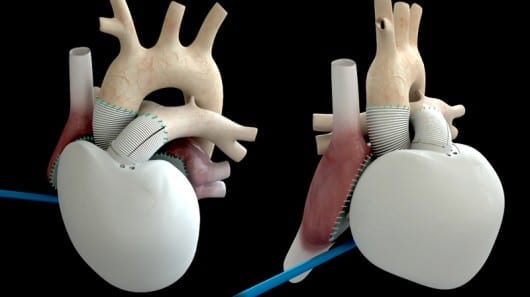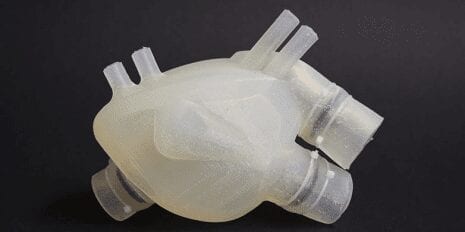
The first Carmat bioprosthetic artificial heart to ever be implanted in a human
Last Wednesday in Paris, a 75 year-old man received an artificial heart. That in itself might not be newsworthy, as such devices have been in use since the early 80s. In this case, however, the gadget in question was the first Carmat bioprosthetic artificial heart to ever be implanted in a human. According to its inventor, cardiac surgeon Alain Carpentier, it’s the world’s first self-regulating artificial heart.
When Carpentier uses the term “self-regulating,” he refers to the Carmat’s ability to speed up or slow down its flow rate based on the patient’s physiological needs – if they’re performing a vigorous physical activity, for instance, the heart will respond by beating faster. This is made possible via “multiple miniature embedded sensors” and proprietary algorithms running on its integrated microprocessor.
Most other artificial hearts, by contrast, beat at a constant unchanging rate. This means that patients either have to avoid too much activity, or risk becoming breathless and exhausted quickly.
According to a Reuters report, although the Carmat is similar in size to a natural adult human heart, it’s a little on the big side. It should therefore fit inside 86 percent of men, but only 20 percent of women – that said, the company has stated that a smaller model could be made. It’s also almost three times heavier than a real heart, tipping the scales at approximately 900 grams (2 lb).
Power comes from an external lithium-ion battery pack worn by the patient, and a fuel cell is in the works.
The Latest on: Artificial heart
[google_news title=”” keyword=”Artificial heart” num_posts=”10″ blurb_length=”0″ show_thumb=”left”]
via Google News
The Latest on: Artificial heart
- AI technology giving heart failure patients better care, more access to doctorson May 9, 2024 at 3:26 pm
Revolutionary technology powered by artificial intelligence is giving heart failure patients better care and more access to doctors and the therapies that they need.
- 2 Millionaire-Maker Artificial Intelligence (AI) Stockson May 9, 2024 at 1:55 am
Snowflake ( SNOW -1.21%) and Super Micro Computer ( SMCI -2.79%) have become pivotal in the development and growth of artificial intelligence (AI) technology. These stocks have the ingredients to ...
- Ohio State student shares heart transplant journey at ECMO Symposiumon May 8, 2024 at 3:58 pm
Gigi Humeidan is one of 45,728 undergraduates at Ohio State, but her journey to this university has been unlike any other. Humeidan, a second-year in health sciences, shared her experience with ...
- AI may help physicians detect abnormal heart rhythms earlieron May 7, 2024 at 9:15 am
An artificial intelligence program developed by investigators in the Smidt Heart Institute and their Cedars-Sinai colleagues can detect a type of abnormal heart rhythm that can go unnoticed during ...
- Artificial heart boy recoverson April 7, 2024 at 5:00 pm
The youngest ever person to receive an artificial heart implant has had it removed when his own heart started working again. Sixteen-year-old Jamie Darney from Port Talbot in south Wales was given ...
- The dream of an artificial heart: how close are we?on January 3, 2024 at 4:18 am
Alternatives are urgently needed. Cardiologists and heart surgeons have been trying to build artificial hearts for over 60 years. For patients who's heart is severely ill but not completely damaged, ...
- 7 Amazing Facts About Your Hearton December 23, 2023 at 4:30 pm
Heard about the guy who lived with an artificial heart for 555 days? It kept him alive while he waited for a heart transplant. Talk about a machine. Your own heart pumps a gallon and a half blood ...
- The artificial heart valveon December 18, 2023 at 11:40 pm
Lowell Edwards (Fig. 1), who asked if I would collaborate with him in the development of an artificial heart. He was serious. I told him it was too soon, that we did not even have satisfactory ...
- New OPB documentary profiles the Oregon-based inventors of the first successful artificial heart valve, a breakthrough in cardiac surgeryon December 14, 2023 at 2:46 am
OPB has premiered a new documentary that traces the development of the world’s first successful artificial mitral heart valve by a young, Oregon-based cardiac surgeon and a retired engineer.
- Permanent Artificial Hearts: Long-Sought Replacements May Not Be Far Awayon August 9, 2021 at 12:17 am
A permanent implantable artificial heart has long been a goal of medicine, and if recent developments in materials science and electrical engineering have anything to say about it, such a device ...
via Bing News










